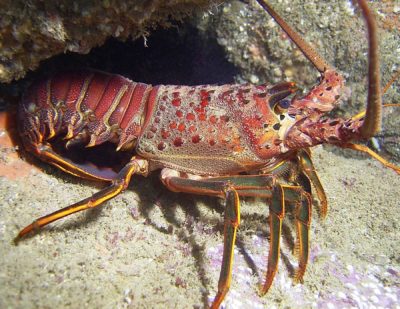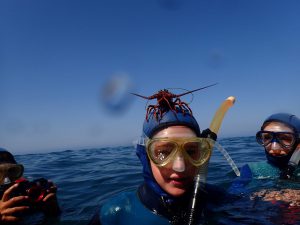
The California spiny lobster is a unique invertebrate (species lacking a backbone) that is found off the coast of southern California. This type of lobster belongs to a group of invertebrates known as Arthropoda. Arthropoda’s characteristics consist of having a segmented body, exoskeleton, and jointed appendages. These lobsters share the same grouping classification as insects and spiders! How cool is that!
 A California spiny lobster hiding in its den.
A California spiny lobster hiding in its den.
The California spiny lobster lacks claws, unlike its friend, the American lobster, which can be found off the eastern coast. They are also reddish-brown in color and have an enlarged pair of antennae, used for sensing their environment. These antennae can also produce a loud clicking noise to warn off predators. California spiny lobster get their name from the forward-pointing spines that cover their bodies to help protect them from predators.

Credit: Tim S
Their hard shell, or exoskeleton, also helps to protect them from predators, but can make growing a challenge. To grow, the lobster must shed their shell to increase their size! This process is called molting. To do this the lobster must reduce the size of their body in the shell, by drawing in as much water as they can, so their shell isn’t too tight. Then, the shell breaks between the tail and their body (otherwise known as a carapace). The lobster will then flex their body back and forth and eventually back out of their old shell. During this period, the lobster is shell-less, and EXTREMELY vulnerable. They must stay hidden because it’s super hard to protect themselves from prey without their hard exoskeleton protecting them. The lobster will then start the process of growing a new shell, which can take several months.

CIMI snorkelers discover a discarded lobster molt in the water!
When it comes to movement in the water, these guys are experts! With ten legs, these lobsters can walk along the sea floor, as well as move backwards and even sideways! However, if they need to move fast from predators, they can tuck their tails under their abdomens and rapidly propel themselves backwards, similar to how octopus and squid move!
These animals are nocturnal, and spend most of their day hiding in rocky crevices. At night, they leave their dens in search of a meal. Their diet ranges from algae and dead organisms to snails, sea urchins, and clams. They have even been known for cannibalism in desperate times, and have been seen feasting on injured or recently molted lobsters!
Whether you see lobsters as an interesting sea creature or a delectable meal, next time you’re at your local supermarket or on a snorkel, be sure to check out everything these amazing creatures have to offer!

Lobsters make great head masseuses and hair stylists, when they’re not busy using their ten legs for scuttling about. Credit: Gabrielle R and Capri L
P.S. For some inspiration from a rabbi on growing through adversity and learning from lobster, click here: http://www.stillworks.org/blog/2016/2/27/how-to-grow-through-stress-lessons-from-a-lobster-by-a-rabbi
Written By: Brooke Fox
References:
https://dtmag.com/thelibrary/spiny-slipper-regal-and-rock-the-secret-lives-of-lobsters/
https://myfwc.com/research/saltwater/crustaceans/lobster/facts/
https://www.followyourfish.com/creature-feature-1/
https://www.lobsters.org/ticbio/biology3.html


